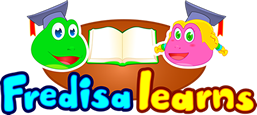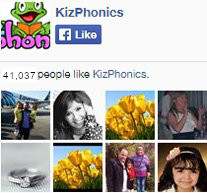Phonics Lesson Plans Made Easy
The Kiz Phonics Resources & Structured Guide to Teaching a Child How to Read
It is not very often that you come across the perfect combination of resources to help kids learn in a progressive and structured manner. That’s KizPhonics for you - a systematic curriculum for teaching kids to read with synthetic phonics. It is supported by the most comprehensive and varied sets of resources that cater to all learning styles – visual, auditory, tactile – hence, we offer - Phonics Videos, Phonics Games, Listening materials, Songs, PowerPoint Lessons, Worksheets, Flashcards etc.
Recommended Steps for Teaching Phonics Sounds with Kizphonics
- Pick a Level: Our materials are structured by level. Levels are structured by ability. Age can be a good indicator of the level – but not always! Kids between the ages of 3 to 5 usually fall under our Preschool Phonics level (Pre-K). At preschool levels, the recognition of the 26 letters and sounds of the alphabet provides a departure point for future lessons. Then kids follow the remaining five levels in our structured phonics program from Kindergarten to 2nd Grade. They learn to blend sounds in reading words, learn sight words and read full sentences. Thus, by the ages of 6 to 8, they should have learned to read competently. Beyond this age, our program can be used as a phonics intervention course for late learners. Still not sure what level to begin with? Here is the trick - Start from the very first level – Preschool. Depending on the child’s ability, they may fly through low levels and start to struggle as they move up. Where they begin to struggle, slow down, and actually start from that level. Alternatively, you can use our Phonics Assessments here to test students - https://www.kizphonics.com/phonics-assessment/. Begin from the lowest to the highest level. Where the scores are poor, you’ve got the level to begin with.
- Phonics Lesson Videos/PowerPoint: Use our phonics lesson videos and PowerPoint to introduce phonemes in a native Californian English accent. Kids need to hear the sounds clearly to grasp the synthetic combinations that make up words. We ensured that the most neutral and crisp accent was used to record our phonics lesson videos. Videos are great things because you can play, pause and rewind them – they never get exhausted. If you’d rather teach in class, we got you covered with our Phonics Lesson PPTs.
- Phonics Games: After watching the videos, play a letter sound game, word family’s game or sentence games that match the sounds taught in the instructional video. We have a phonics game for every sound and lesson video! Games are especially great for kinaesthetic/tactile learners because their learning is completed only when they move stuff around. The drag and drop options in games allow such learners to take charge of their learning – most kids are. Follow up with an exercise in the physical world such as flashcard game or printable that complements the interactive computer game. We have phonics games on – Word Families, Phonemic Practice Games, Sentence Games, Vowel Digraphs, Letter Sound Games etc.
- Phonics Worksheets/Listening Exercise: Our phonics worksheets are PDF files, actually taken from our phonics books - so these are workbook exercises of the highest quality! There are worksheets to teach - long vowel sounds, short vowels, vowel digraphs, consonants and consonant blends, consonant digraphs and more. Each worksheet is accompanied by listening material which can be found on our audio media players – by level. Each listening exercise is easy to locate on the media player as it features an icon that matches the worksheet. The audio is recorded in the same crisp Californian female voice that gets kids hooked. Before you know it, your child will be reading words and sentences.
- Phonics Sentences & Stories: From Kindergarten Phonics levels, there are phonics stories and sentence activities to move learners closer to reading books. We offer 21 Phonics Stories and 15 sentence games with simple phonics sentences designed around key vowels.
- Finally, Assess: When you feel the learners have mastered all the contents of a level, assess them with our comprehensive phonics level tests. These tests include a reading test of real words, non-words, and sentence reading. Non-word tests are instrumental in determining if a child is reading based on word recognition or phonemic awareness. Thus, they can be a very powerful way of determining mastery. If your learner’s performance is good, progress to the next level. If not, review areas the test has identified as needing extra effort, then test again.
- Supplemental Resources: The above steps are just the essentials. Remember, we offer many additional resources such as phonics flashcards, phonics songs, board games, and more.
Finally, it is essential to point out that our materials can also be used to supplement an existing phonics curriculum. Further, they can be used for phonics intervention and incidental phonics lessons. Ultimately, there are myriad creative ways in which our materials can be used – so apply your creativity based on circumstances. There is something in KizPhonics here for everyone.











